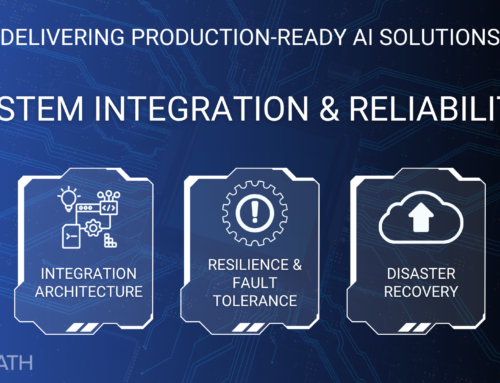Your AI system is running in production. Users are getting results. The technology appears to be working. Then someone asks a simple question that exposes a fundamental problem: "How do we know if it's working well?"
This question reveals the AI black box dilemma that catches most organizations off guard. Traditional business systems provide clear visibility into their operations. You can see transaction volumes, error rates, user activity, and performance metrics. AI systems often operate as mysterious processes that produce outputs without explaining how they reached those conclusions or whether those conclusions are getting better or worse over time.
Without proper visibility and operational controls, AI systems become expensive question marks. You're never quite sure if they're delivering value, developing problems, or creating risks that could affect your business reputation or regulatory standing.
The Visibility Gap That Creates Expensive Surprises
Most AI discussions focus on what the technology can do rather than how you'll know if it's doing it well. This creates operational blind spots that become serious business problems:
Performance degradation that goes unnoticed until customer complaints reveal that your AI-powered customer service has been providing poor responses for weeks. The system never crashed, error logs look normal, but business outcomes quietly deteriorated.
Bias emergence that creates compliance risks when your hiring AI gradually begins favoring certain demographic groups without anyone noticing the shift. The individual decisions seem reasonable, but the pattern creates legal liability and reputation damage.
Cost escalation that explodes budgets when AI usage grows or changes in ways that dramatically increase cloud computing bills. The system works perfectly from a technical perspective, but operating costs become unsustainable.
Decision patterns that drift from business objectives when market conditions change but AI systems continue using outdated training data or optimization targets. The technology performs consistently but delivers less business value over time.
These problems don't announce themselves through traditional monitoring approaches. They require specialized visibility into AI operations and business impact that most organizations either skip entirely or implement as afterthoughts.
For this reason, CtiPath developed the Production-Ready AI Solutions Framework. The fourth part of that framework is Operations & Visibility.
The Two Elements That Transform AI from Mystery to Managed Asset
Successfully operating AI in business environments requires systematic approaches to visibility and operational management that treat AI systems as business assets rather than technical experiments.
Element 11: Monitoring, Observability, and Explainability – Seeing Inside the Black Box
Comprehensive AI monitoring provides real-time visibility into both technical performance and business impact while enabling stakeholders to understand and validate AI decision-making.
Business outcome tracking that connects AI performance to results measures what actually matters: customer satisfaction improvements, cost reductions, process efficiency gains, and revenue impact. Technical metrics like model accuracy matter, but business metrics determine whether AI investments create value.
Real-time performance monitoring that catches problems early identifies degradation before it affects business operations. Your fraud detection AI might maintain good overall accuracy while becoming less effective at catching the types of fraud that cost the most money.
Bias detection across actual user populations monitors AI decisions for disparate impact across demographic groups, geographic regions, time periods, and other relevant criteria. This monitoring needs to understand your specific business context and regulatory requirements.
Decision audit trails that support accountability maintain detailed records of AI decision-making including input data, confidence levels, reasoning processes, and final outputs. These trails enable investigation when decisions are questioned and support regulatory compliance requirements.
Explainability frameworks that serve different stakeholder needs provide appropriate levels of transparency for various audiences: technical teams need detailed diagnostic information, business users need decision rationale they can understand, and regulators need audit-ready documentation.
Predictive monitoring that identifies emerging issues uses patterns in AI performance data to predict potential problems before they impact business operations. Gradual changes in data quality, usage patterns, or model behavior often signal issues that require proactive attention.
The goal isn't just monitoring AI systems; it's creating visibility that enables confident decision-making about AI operations, optimization, and expansion.
Element 12: Operational Maintainability and Cost Control – Keeping AI Sustainable
Operational maintainability ensures that AI systems remain cost-effective and manageable throughout their lifecycle while minimizing the human effort required for ongoing operations.
Automated maintenance procedures that reduce operational overhead handle routine tasks including system updates, performance optimization, backup verification, and health monitoring without requiring constant manual attention. AI systems that need extensive human intervention often become too expensive to operate sustainably.
Cost optimization that adapts to changing usage patterns automatically adjusts resource allocation based on actual demand while monitoring for usage changes that might affect budget projections. AI costs can scale unpredictably with business success, requiring proactive management.
Performance tuning that maintains efficiency over time ensures that AI systems continue operating efficiently as data volumes grow, usage patterns change, and business requirements evolve. Systems optimized for initial deployment often require ongoing adjustment to maintain cost-effectiveness.
Operational documentation that enables effective management provides clear procedures for routine maintenance, troubleshooting common issues, performance optimization, and emergency response. This documentation enables operations teams to manage AI systems effectively without requiring specialized AI expertise for routine tasks.
Resource utilization monitoring that identifies optimization opportunities tracks how efficiently AI systems use computational resources, identifies underutilized capacity, and highlights opportunities to reduce costs without compromising performance.
Total cost of ownership analysis that guides optimization decisions tracks complete operational costs including infrastructure, software licenses, operational overhead, and hidden expenses that often surprise organizations as AI systems scale.
Effective operational maintainability transforms AI from expensive experimental technology into sustainable business capability that delivers value consistently over time.
How Visibility and Operations Enable AI Success
Organizations that invest properly in monitoring and operational capabilities experience fundamentally different AI outcomes than those that deploy AI systems without adequate visibility or operational planning.
Proactive problem identification prevents expensive failures because monitoring systems detect issues before they impact business operations or customer experience. Problems get resolved quickly rather than escalating into major incidents.
Continuous optimization improves results over time because visibility into AI performance enables data-driven improvements in model selection, resource allocation, and business process integration. AI systems get better rather than degrading as conditions change.
Stakeholder confidence enables ambitious applications because business leaders can see evidence that AI systems are working effectively and delivering measurable value. This transparency supports deployment in mission-critical processes and larger organizational investments.
Regulatory compliance becomes manageable because comprehensive monitoring and documentation provide the audit trails and decision transparency that regulators require. Compliance activities become routine rather than crisis-driven.
Cost management prevents budget surprises because ongoing monitoring identifies cost trends and optimization opportunities before they become serious budget problems. AI operations remain sustainable as usage scales.
Organizational learning accelerates AI adoption because visibility into what works and what doesn't enables better decision-making about future AI investments and implementations.
Questions That Reveal Operational Readiness
When evaluating AI initiatives, these questions reveal whether monitoring and operational concerns are properly addressed:
Monitoring and Observability: How do you track whether AI decisions are actually improving business outcomes? What procedures identify bias or performance degradation before they affect operations? How do you explain AI decisions to stakeholders who need to understand and trust the results?
Operational Maintainability: What ongoing maintenance does the AI system require and who will perform it? How do operational costs scale as usage grows? What documentation and procedures enable effective long-term management by your existing teams?
Cost Control: How do you monitor and optimize AI-related expenses? What happens to costs as business usage scales? How do you identify and eliminate resource waste without compromising system performance?
Business Impact Measurement: How do you connect AI system performance to actual business results? What metrics demonstrate that AI investments are delivering expected value? How do you optimize AI operations for business outcomes rather than just technical performance?
Detailed answers that address real-world operational complexity suggest mature approaches to AI management. Vague responses or focus purely on AI capabilities indicate gaps that will create expensive operational challenges.
The Investment That Makes AI Sustainable
Building comprehensive monitoring and operational capabilities requires more upfront planning than deploying AI systems without operational considerations. But this investment creates sustainable competitive advantages:
Predictable operational costs that scale reasonably with business value rather than creating budget surprises that threaten AI program sustainability.
Continuous performance improvement through data-driven optimization based on actual usage patterns and business impact measurement rather than theoretical performance targets.
Organizational confidence in AI capabilities that enables deployment in business-critical processes and larger strategic investments based on demonstrated value delivery.
Regulatory readiness that supports AI deployment in regulated industries through comprehensive monitoring and documentation that meets compliance requirements.
Operational efficiency that enables small teams to manage complex AI systems effectively while maintaining high performance and reliability standards.
Strategic decision-making based on clear visibility into AI performance, costs, and business impact rather than hoping that AI investments will deliver expected value.
Beyond the Black Box: Building AI You Can Actually Manage
The AI transformation is real, but capturing its benefits requires treating AI systems as business assets that need proper operational management rather than experimental technology that operates in isolation.
Organizations that invest in comprehensive monitoring and sustainable operational practices position themselves to deploy AI confidently across their enterprise while maintaining clear visibility into performance, costs, and business impact. Those that assume AI systems will operate themselves effectively often discover expensive operational challenges that limit AI value or create unexpected liabilities.
AI systems don't need to be mysterious black boxes. With proper monitoring and operational design, they become transparent, manageable business tools that deliver measurable value while providing the visibility and control that business leaders need to make confident decisions about AI investments and expansion.
The question isn't whether AI can deliver business value. It's whether you can see and manage that value delivery consistently over time.





